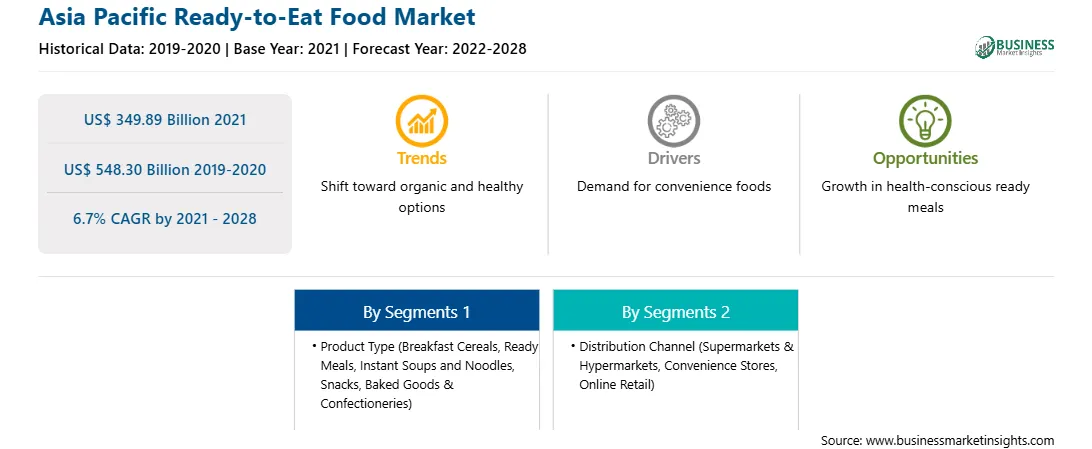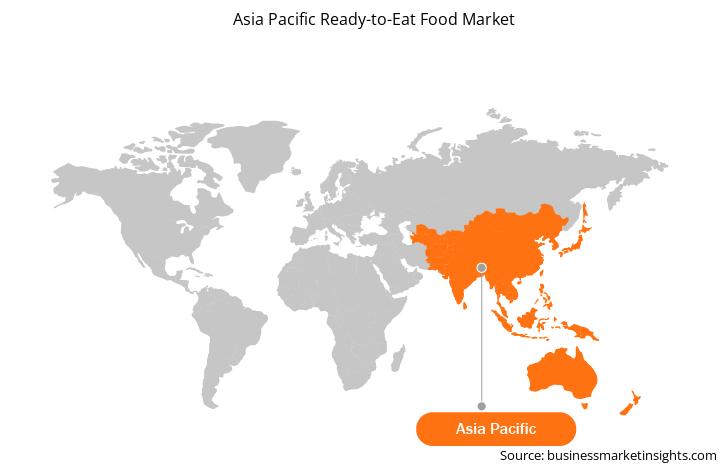The ready-to-eat food market in Asia Pacific is expected to grow from US$ 349.89 billion in 2021 to US$ 548.30 billion by 2028. It is estimated to grow at a CAGR of 6.7% from 2021 to 2028.
In recent decades, women's participation in workforces in different countries has increased tremendously. Such a significant rise in women's employment boosts the popularity of convenience food among working-class populations. These food products can be easily procured, stored, served, or eaten, thus proving convenient by saving time and physical energy. Additionally, a rise in the working women population has transformed people's eating habits.
In Asia, female labor force participation ranges from 16% in Afghanistan to 83% in Nepal, further growing in several other countries in the region. The female labor force across many countries in the region has increased exponentially. The growth in participation began at different points in time, and proceeded at different rates; nonetheless, the substantial and sustained growth in the participation of women in labor forces in rich countries remained a striking feature of economic and social developments in the 20th century. Thus, this factor is potentially contributing to the growth of the ready-to-eat food market.
With new features and technologies, vendors can attract new customers and expand their footprints in emerging markets. This factor is likely to drive the Asia Pacific ready-to-eat food market at a substantial CAGR during the forecast period.
Asia Pacific Ready-to-Eat Food Market Segmentation
The Asia Pacific ready-to-eat food market is segmented on the basis of product type, distribution channel, and country. Based on product type, the market is segmented into breakfast cereals, ready meals, instant soups and noodles, snacks, baked goods & confectioneries, and others. In 2021, the others segment held a larger market share, and the ready meal segment is expected to register a higher CAGR during the forecast period.
Based on distribution channel, the market is segmented into supermarkets & hypermarkets, convenience stores, online retail, and others. In 2021, the convenience stores segment held the largest market share, and the online retail segment is expected to register the highest CAGR in the market during the forecast period.
Based on country, the market is segmented into China, Japan, India, Australia, South Korea, and the Rest of Asia Pacific. In 2021, the Rest of Asia Pacific held the largest market share, and India is expected to grow at the fastest CAGR during the forecast period.
Nestlé SA; Conagra Brands Inc.; The Kraft Heinz Company; General Mills Inc.; MTR Foods Pvt Ltd.; Hormel Foods Corporation; JBS S.A.; Tyson Foods, Inc.; and The Kellogg Company are a few leading companies in the Asia Pacific ready-to-eat food market.
Strategic insights for the Asia Pacific Ready-to-Eat Food provides data-driven analysis of the industry landscape, including current trends, key players, and regional nuances. These insights offer actionable recommendations, enabling readers to differentiate themselves from competitors by identifying untapped segments or developing unique value propositions. Leveraging data analytics, these insights help industry players anticipate the market shifts, whether investors, manufacturers, or other stakeholders. A future-oriented perspective is essential, helping stakeholders anticipate market shifts and position themselves for long-term success in this dynamic region. Ultimately, effective strategic insights empower readers to make informed decisions that drive profitability and achieve their business objectives within the market.

| Report Attribute | Details |
|---|---|
| Market size in 2021 | US$ 349.89 Billion |
| Market Size by 2028 | US$ 548.30 Billion |
| CAGR (2021 - 2028) | 6.7% |
| Historical Data | 2019-2020 |
| Forecast period | 2022-2028 |
| Segments Covered |
By Product Type
|
| Regions and Countries Covered | Asia-Pacific
|
| Market leaders and key company profiles |
|
The geographic scope of the Asia Pacific Ready-to-Eat Food refers to the specific areas in which a business operates and competes. Understanding local distinctions, such as diverse consumer preferences (e.g., demand for specific plug types or battery backup durations), varying economic conditions, and regulatory environments, is crucial for tailoring strategies to specific markets. Businesses can expand their reach by identifying underserved areas or adapting their offerings to meet local demands. A clear market focus allows for more effective resource allocation, targeted marketing campaigns, and better positioning against local competitors, ultimately driving growth in those targeted areas.

The Asia Pacific Ready-to-Eat Food Market is valued at US$ 349.89 Billion in 2021, it is projected to reach US$ 548.30 Billion by 2028.
As per our report Asia Pacific Ready-to-Eat Food Market, the market size is valued at US$ 349.89 Billion in 2021, projecting it to reach US$ 548.30 Billion by 2028. This translates to a CAGR of approximately 6.7% during the forecast period.
The Asia Pacific Ready-to-Eat Food Market report typically cover these key segments-
The historic period, base year, and forecast period can vary slightly depending on the specific market research report. However, for the Asia Pacific Ready-to-Eat Food Market report:
The Asia Pacific Ready-to-Eat Food Market is populated by several key players, each contributing to its growth and innovation. Some of the major players include:
The Asia Pacific Ready-to-Eat Food Market report is valuable for diverse stakeholders, including:
Essentially, anyone involved in or considering involvement in the Asia Pacific Ready-to-Eat Food Market value chain can benefit from the information contained in a comprehensive market report.